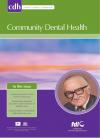Community Dental Health

- Cover Date:
- December 2006
- Print ISSN:
- 0265 539X
- Vol:
- 23
- Issue:
- 4
DIAGNOdent - an adjunctive diagnostic method for caries diagnosis in epidemiology
The DIAGNOdent system is intended as an aid to caries detection and has undergone extensive investigation in experimental and clinical studies. Its applicability for epidemiological purposes has yet to be evaluated. The Objective of the present study was to evaluate the DIAGNOdent system under ï¬eld conditions. Basic Research design: The subjects comprised a sub-sample from an on-going epidemiological study. Participants and Clinical setting: In 39 individuals, 97 sites were visually identiï¬ed as possibly carious: 42 occlusal, 13 lingual, 19 buccal and 23 approximal sites. Main outcome measures: Three DIAGNOdent measurements were taken at each site under varying conditions: 1) naturally wet, 2) dried, and 3) polished and dried surfaces. Three sets of measurements were obtained and compared by intra-class correlation and paired sample t-tests. Results: All correlation coefï¬cients were > 0.9. There was a systematic difference between mean scores from naturally wet sites (without cleaning) and from either dried, or polished and dried sites. The difference was marginal and did not impact on the threshold for recording sites as carious. In two subjects, high unexpected values were recorded on sound sites prior to actual measurements, i.e. during establishment of a standard value for a sound site. The overall ï¬ndings were not affected by these values, as they were consistently high in all three measurements. Conclusions: The DIAGNOdent system performed satisfactorily under different measurement conditions. The present study indicates that the DIAGNOdent system would be applicable in ï¬eld studies, provided consistent study conditions are maintained and unexpected values are interpreted with caution.
Key words: caries diagnosis, epidemiology, DIAGNOdent
- Article Price
- £15.00
- Institution Article Price
- £
- Page Start
- 217
- Page End
- 221
- Authors
- Aleksejuniene J, Tranæus S, Skudutyte-Rysstad R
Articles from this issue
- Title
- Pg. Start
- Pg. End
- The relationship between prevalence and incidence of dental caries. Some observational consequences.
- 203
- 208
- Prevalence and factors associated with traumatic dental injuries (TDI) to anterior teeth of 11-13 year old Thai children
- 222
- 227
- A survey of school dental screening practise in community dental services of England and Wales in 2003
- 236
- 238
- The prevalence and pattern of hypodontia of the permanent teeth and crown size and shape deformity affecting upper lateral incisors in a sample of Jordanian dental patients.
- 239
- 243
- Relationship between dental caries experience (DMFS) and dental fluorosis in 12-year-old Puerto Ricans.
- 244
- 250
- Prevalence of dental caries in obese and normal-weight Brazilian adolescents attending state and private schools.
- 251
- 253
